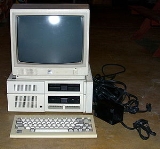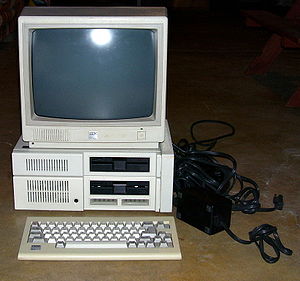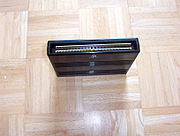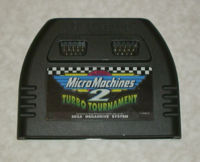
ROM cartridge
Encyclopedia



Read-only memory
Read-only memory is a class of storage medium used in computers and other electronic devices. Data stored in ROM cannot be modified, or can be modified only slowly or with difficulty, so it is mainly used to distribute firmware .In its strictest sense, ROM refers only...
devices designed to be connected to a computer
Computer
A computer is a programmable machine designed to sequentially and automatically carry out a sequence of arithmetic or logical operations. The particular sequence of operations can be changed readily, allowing the computer to solve more than one kind of problem...
or games console.
ROM cartridges can be used to add additional functionality or content to the host machine, hardware additions like speech synthesis
Speech synthesis
Speech synthesis is the artificial production of human speech. A computer system used for this purpose is called a speech synthesizer, and can be implemented in software or hardware...
, or software such as video games.
History
ROM cartridges were popularized by early home computerHome computer
Home computers were a class of microcomputers entering the market in 1977, and becoming increasingly common during the 1980s. They were marketed to consumers as affordable and accessible computers that, for the first time, were intended for the use of a single nontechnical user...
s which featured a special bus port for the insertion of cartridges containing software in ROM
Read-only memory
Read-only memory is a class of storage medium used in computers and other electronic devices. Data stored in ROM cannot be modified, or can be modified only slowly or with difficulty, so it is mainly used to distribute firmware .In its strictest sense, ROM refers only...
. In most cases the designs were fairly crude, with the entire address
Address bus
An address bus is a computer bus that is used to specify a physical address. When a processor or DMA-enabled device needs to read or write to a memory location, it specifies that memory location on the address bus...
and data buses exposed by the port and attached via an edge connector
Edge connector
An edge connector is the portion of a printed circuit board consisting of traces leading to the edge of the board that are intended to plug into a matching socket. The edge connector is a money-saving device because it only requires a single discrete female connector , and they also tend to be...
; the cartridge was memory map
Memory map
In computer science, a memory map is a structure of data that indicates how memory is laid out. Memory maps can have a different meaning in different parts of the operating system....
ped directly into the system's address space
Address space
In computing, an address space defines a range of discrete addresses, each of which may correspond to a network host, peripheral device, disk sector, a memory cell or other logical or physical entity.- Overview :...
.
Notable computers using cartridges in addition to magnetic media were the Commodore VIC-20 and 64
Commodore 64
The Commodore 64 is an 8-bit home computer introduced by Commodore International in January 1982.Volume production started in the spring of 1982, with machines being released on to the market in August at a price of US$595...
, the Atari 8-bit family
Atari 8-bit family
The Atari 8-bit family is a series of 8-bit home computers manufactured from 1979 to 1992. All are based on the MOS Technology 6502 CPU and were the first home computers designed with custom coprocessor chips...
(400/800/XL/XE), the Texas Instruments
Texas Instruments
Texas Instruments Inc. , widely known as TI, is an American company based in Dallas, Texas, United States, which develops and commercializes semiconductor and computer technology...
TI-99/4A (where they were called Solid State Command Modules and were not directly mapped to the system bus) and the IBM
IBM
International Business Machines Corporation or IBM is an American multinational technology and consulting corporation headquartered in Armonk, New York, United States. IBM manufactures and sells computer hardware and software, and it offers infrastructure, hosting and consulting services in areas...
PCjr (where the cartridge was mapped into BIOS
BIOS
In IBM PC compatible computers, the basic input/output system , also known as the System BIOS or ROM BIOS , is a de facto standard defining a firmware interface....
space).
From the late 1970s to mid-1990s, the majority of home video game systems
Video game console
A video game console is an interactive entertainment computer or customized computer system that produces a video display signal which can be used with a display device to display a video game...
were cartridge-based. The first system to make use of ROM cartridges was the Fairchild Channel F
Fairchild Channel F
The Fairchild Channel F is a game console released by Fairchild Semiconductor in August 1976 at the retail price of $169.95. It has the distinction of being the first programmable ROM cartridge-based video game console...
. As compact disc
Compact Disc
The Compact Disc is an optical disc used to store digital data. It was originally developed to store and playback sound recordings exclusively, but later expanded to encompass data storage , write-once audio and data storage , rewritable media , Video Compact Discs , Super Video Compact Discs ,...
technology came to be used widely for data storage, most hardware companies moved from cartridges to CD-based game systems. Nintendo
Nintendo
is a multinational corporation located in Kyoto, Japan. Founded on September 23, 1889 by Fusajiro Yamauchi, it produced handmade hanafuda cards. By 1963, the company had tried several small niche businesses, such as a cab company and a love hotel....
remained the lone hold-out, using cartridges for their Nintendo 64
Nintendo 64
The , often referred to as N64, was Nintendo′s third home video game console for the international market. Named for its 64-bit CPU, it was released in June 1996 in Japan, September 1996 in North America, March 1997 in Europe and Australia, September 1997 in France and December 1997 in Brazil...
system; the company did not transition to optical media until 2001's GameCube.
Business and personal use
Personal computers which used cartridges include the Atari 8-bit familyAtari 8-bit family
The Atari 8-bit family is a series of 8-bit home computers manufactured from 1979 to 1992. All are based on the MOS Technology 6502 CPU and were the first home computers designed with custom coprocessor chips...
, the IBM PCjr
IBM PCjr
The IBM PCjr was IBM's first attempt to enter the home computer market. The PCjr, IBM model number 4860, retained the IBM PC's 8088 CPU and BIOS interface for compatibility, but various design and implementation decisions led the PCjr to be a commercial failure.- Features :Announced November 1,...
, and the Commodore family of systems.
Gaming
Game systems that used cartridges include:- AtariAtariAtari is a corporate and brand name owned by several entities since its inception in 1972. It is currently owned by Atari Interactive, a wholly owned subsidiary of the French publisher Atari, SA . The original Atari, Inc. was founded in 1972 by Nolan Bushnell and Ted Dabney. It was a pioneer in...
gaming consoles - Mattel Intellivision
- ColecoVisionColecoVisionThe ColecoVision is Coleco Industries' second generation home video game console which was released in August 1982. The ColecoVision offered arcade-quality graphics and gaming style, and the means to expand the system's basic hardware...
- Nintendo Entertainment SystemNintendo Entertainment SystemThe Nintendo Entertainment System is an 8-bit video game console that was released by Nintendo in North America during 1985, in Europe during 1986 and Australia in 1987...
(NES) - Super Nintendo Entertainment SystemSuper Nintendo Entertainment SystemThe Super Nintendo Entertainment System is a 16-bit video game console that was released by Nintendo in North America, Europe, Australasia , and South America between 1990 and 1993. In Japan and Southeast Asia, the system is called the , or SFC for short...
(SNES) - Nintendo 64Nintendo 64The , often referred to as N64, was Nintendo′s third home video game console for the international market. Named for its 64-bit CPU, it was released in June 1996 in Japan, September 1996 in North America, March 1997 in Europe and Australia, September 1997 in France and December 1997 in Brazil...
- Game BoyGame BoyThe , is an 8-bit handheld video game device developed and manufactured by Nintendo. It was released in Japan on , in North America in , and in Europe on...
series - Sega Master SystemSega Master SystemThe is a third-generation video game console that was manufactured and released by Sega in 1985 in Japan , 1986 in North America and 1987 in Europe....
- Sega Mega DriveSega Mega DriveThe Sega Genesis is a fourth-generation video game console developed and produced by Sega. It was originally released in Japan in 1988 as , then in North America in 1989 as Sega Genesis, and in Europe, Australia and other PAL regions in 1990 as Mega Drive. The reason for the two names is that...
(Genesis) - Game Gear
- Neo GeoNeo Geowas a family of video game hardware developed by SNK from 1990 to 1999, and fully discontinued in 2004.-Neo Geo MVS :The Neo Geo Multi Video System , is an arcade system board, being the first product in the Neo Geo family, and released in 1990...
- LeapsterLeapsterThe Leapster Learning Game System is an educational handheld game console aimed at 4 to 10 year olds , made by LeapFrog Enterprises. Its games teach the alphabet, phonics, basic math , and art and animal facts to players...
ROM cartridges can not only carry software, but additional hardware expansion as well. Examples include the Super FX
Super FX
The Super FX is a coprocessor chip used in select Super Nintendo Entertainment System video game cartridges. This custom-made RISC processor was typically programmed to act like a graphics accelerator chip that would draw polygons to a frame buffer in the RAM that sat adjacent to it...
coprocessor chip in some Super Nintendo
Super Nintendo Entertainment System
The Super Nintendo Entertainment System is a 16-bit video game console that was released by Nintendo in North America, Europe, Australasia , and South America between 1990 and 1993. In Japan and Southeast Asia, the system is called the , or SFC for short...
games, and voice and chess
Chess
Chess is a two-player board game played on a chessboard, a square-checkered board with 64 squares arranged in an eight-by-eight grid. It is one of the world's most popular games, played by millions of people worldwide at home, in clubs, online, by correspondence, and in tournaments.Each player...
modules in the Magnavox Odyssey²
Magnavox Odyssey²
The Magnavox Odyssey², known in Europe as the Philips Videopac G7000, in Brazil as the Philips Odyssey, in the United States as the Magnavox Odyssey² and the Philips Odyssey², and also by many other names, is a video game console released in 1978.In the early 1970s, Magnavox was an innovator in the...
.
Micro Machines 2 on the Sega Megadrive used a custom "J-Cart
J-Cart
The J-Cart was a special cartridge developed by Codemasters for the Sega Mega Drive console. It held not only the game data but also came with two additional gamepad ports. This effectively allowed four players to play simultaneously without any adapters or workarounds...
" cartridge design by Codemasters
Codemasters
The Codemasters Software Company Limited, or Codemasters is a British video game developer founded by Richard and David Darling in 1986...
which incorporated two additional gamepad
Gamepad
A gamepad , is a type of game controller held in two hands, where the digits are used to provide input. Gamepads generally feature a set of action buttons handled with the right thumb and a direction controller handled with the left...
ports. This allowed players to have up to four gamepads connected to the console without the need for an additional third-party adaptor.
Advantages and disadvantages
Storing software on ROM cartridges has a number of advantages over other methods of storage like floppy disks and optical media. As the ROM cartridge is memory mapped into the system's normal address space, software stored in the ROM can be read like normal memory; since the system does not have to transfer data from slower media, it allows for nearly instant load time and code execution. Software run directly from ROM typically uses less RAM, leaving memory free for other processes. While the standard size of optical media dictates a minimum size for devices which can read disks, ROM cartridges can be manufactured in different sizes, allowing for smaller devices like handheld game systemsHandheld game console
A handheld game console is a lightweight, portable electronic device with a built-in screen, game controls and speakers. Handheld game consoles are run on machines of small size allowing people to carry them and play them at any time or place...
. And while ROM cartridges can be damaged, they are generally more robust and resistant to damage than optical media; accumulation of dirt and dust on the cartridge contacts can cause problems, but cleaning the contacts with an isopropyl alcohol
Isopropyl alcohol
Isopropyl alcohol is a common name for a chemical compound with the molecular formula C3H8O. It is a colorless, flammable chemical compound with a strong odor...
solution typically resolves the problems without risk of corrosion.
However, ROM cartridges are typically more expensive to manufacture than disks, and storage space available on a ROM cartridge is less than that of an optical disk like a DVD-ROM or CD-ROM
CD-ROM
A CD-ROM is a pre-pressed compact disc that contains data accessible to, but not writable by, a computer for data storage and music playback. The 1985 “Yellow Book” standard developed by Sony and Philips adapted the format to hold any form of binary data....
. As video games became more complex (and the size of their code grew), software manufacturers began sacrificing the quick load time of ROM cartridges for the greater capacity and lower cost of optical media.

